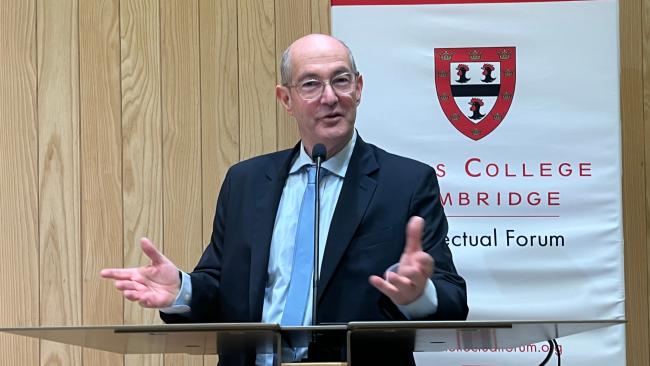
Freedom and Equality: New book by Professor Clare Chambers
Should the state recognise gender? Can a liberal state discourage traditional family structures? Is women's sport compatible with equality of opportunity? Should feminists defend women's freedom to choose cosmetic surgery? Is genital cutting always wrong, or is it only wrong for girls? These are just some of the subjects discussed in a new academic book by Professor Clare Chambers exploring feminist liberalism.
Can you give us an overview of your new book?
Freedom & Equality investigates the contours of feminist liberalism: a philosophical approach defined as a liberalism that prioritises equality and individual autonomy, while offering a rigorous critique of using individuals’ choices as the measure of justice. From beauty norms to the gendered division of labour, from marriage to religion, women and men choose to arrange their lives in ways that perpetuate inequality. Often, these choices are made in response to social norms, including unjust, unequal, or harmful norms. It follows that relying on individual choice as a measure of justice actually leaves unjust social structures intact. Any defender of autonomy and equality must be prepared to criticise individuals’ choices while prioritising individual choosers. The essays in this collection cover a wide range of issues fundamental to liberalism, to feminism, and to their intersection and they all touch on three questions. What does freedom require? What does equality require? And are they compatible?
What led you to publish this book now?
The book discusses many topical issues, some of which have caused great division within philosophy and polarised wider public opinion. In particular, issues of gender identity, women-only spaces, and trans inclusion have become profoundly controversial and raise many questions relevant to public policy. Body image and appearance anxiety has reached epidemic proportions, particularly among girls and women. And the challenge of combining paid work, housework, and childcare is ever more pressing now many families rely on two parents working full-time.
Does it contain any previously unpublished material?
Yes, three chapters are completely new.
Chapter 5 is called “Liberalism, Feminism, and the Gendered Division of Labour”
Most feminists have argued that the gendered division of labour, according to which men specialise in career and paid employment while women specialise in unpaid domestic and care work, is a profound instance of gender injustice. Many liberals have argued that, even if the gendered division of labour creates and sustains inequality, it is essential to protect people’s ability to choose the family structure that works best for them. On this issue, feminists and liberals seem to be in stalemate. This chapter argues that the solution to the gendered division of labour is not to elevate paid employment above unpaid carework, as a liberal perspective tends to do. Instead, the solution starts with recognising that the gendered division of labour depends upon the systematic, enduring devaluation of care and domestic work and proceeds by resisting that devaluation. In this context, the injustice of the gendered division of labour cannot be solved by pushing mothers into paid employment. For the gendered division of labour truly to be undermined, women must be valued for what they do, including care and domestic work.
Chapter 6 asks “Should the Liberal State Recognise Gender?”. It uses the arguments I’ve previously made against the state recognition of marriage and applies them to the case of gender. The chapter argues that a political liberal state cannot recognise gender since doing so would require it to define gender and enforce that definition, something that cannot be done without running counter to reasonable conceptions of the good. It follows that alternative methods to rectify the injustice of the gender binary must be sought. The chapter considers the difference between state recognition of gender and state recognition of sex, and argues for context-dependent solutions.
Chapter 10 is called “Equality of Opportunity and Three Justifications for Women's Sport: Fair Competition, Anti-Sexism, and Identity”. There is currently a divisive public debate about whether trans women should be eligible to compete in women’s sport, with prominent voices on both sides. Various sporting authorities have passed regulations that allow trans women to compete in women’s competitions, including those that award titles, records, and scholarships. Several elite athletes have strongly criticised those rules, arguing that they are unfair to women who are not trans, and some sporting bodies have announced a return to sex-based categories. The debate is muddled, and it rests on a prior question that is often obscured: is women’s sport justified at all? Any justification of women’s sport must engage directly with questions of equality of opportunity, discrimination, and identity. This chapter identifies three possible justifications for women’s sport: the fair competition argument, the anti-sexism argument, and the identity argument. Each argument has merit. However, the arguments are in tension with each other at key points, and they have different implications for trans inclusion. Which argument should prevail depends on the social facts, the sporting context, and the sport itself. The chapter maps the argumentative terrain, showing where the key choices lie; it therefore aims to elucidate rather than end the public and philosophical debate. But it offers a general framework within which to think about dilemmas of discrimination, difference, and equality.
Who do you hope will read this book and what impact do you hope it will have?
The book is aimed at students and scholars of feminism, philosophy, and politics, and anyone who is interested in the challenge of how to maintain individual freedom while addressing the challenge of persistent social inequality. I hope it will engage readers, stimulate debate, and offer new ways forward.




